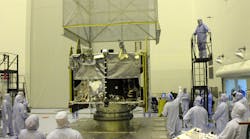As part of the first dedicated mission to survey the upper atmosphere of Mars, Lockheed Martin has delivered NASA’s Mars Atmosphere and Volatile EvolutioN (MAVEN) spacecraft to the Kennedy Space Center in Florida. Scientists hope to use the collected data to determine the role that the loss of volatile compounds, such as carbon dioxide and nitrogen dioxide, had on changing the planet’s atmosphere. After all, Mars evolved from a planet that was potentially habitable by microbial life into a desolate, water-less world.
A standout feature aiding this study is MAVEN’s high-gain antenna (HGA), which is actually fixed along the craft’s +Z-axis [unlike the gimbaled antennas aboard the Mars Reconnaissance Orbiter (MRO) and the Mars Global Surveyor (MGS)]. The fixed-HGA, which has a 2-m, dual-reflector X-band downlink, boasts rates to 550 kb/s. It measures 6.5 feet in diameter by 3.3 feet tall. The reflector is made of a Kevlar honeycomb core, which is placed between two composite face sheets.
With its re-installation, the MAVEN’s HGA results in a more stable signal. Because of the antenna’s positioning, however, communication with Earth during the science phase requires rotating the entire spacecraft. These constraints mean that the HGA models only point toward Earth twice a week for approximately five hours. All other communications--specifically navigation--go through the low-gain antenna (LGA) on the orbiter in time for them to be processed into sequence products and uplinked during the HGA’s designated window.
Set to launch aboard a United Launch Alliance Atlas V-401 rocket from Cape Canaveral Air Force Station in November, the orbiter is currently undergoing its final months of processing. This stage includes software testing, propellant loading, a spin balance, a second solar-array deployment and illumination test, and a payload deployment test.
Principal investigations of the MAVEN are based at the Laboratory for Atmospheric and Space Physics at the University of Colorado. NASA’s Goddard Space Flight Center manages the entire project and provides necessary instruments along with the Berkeley Space Sciences Laboratory at the University of California. Navigation support, the Deep Space Network, and the Electra telecommunications relay hardware and operations are provided by NASA’s Jet Propulsion Laboratory in Pasadena, CA.
Information about the MAVEN’s antenna was provided by the paper, “Navigation Challenges in the MAVEN Science Phase,” which was released by the Jet Propulsion Laboratory at the California Institute of Technology in Pasadena, CA. More information about the MAVEN’s mission can be found at http://www.nasa.gov/maven.
